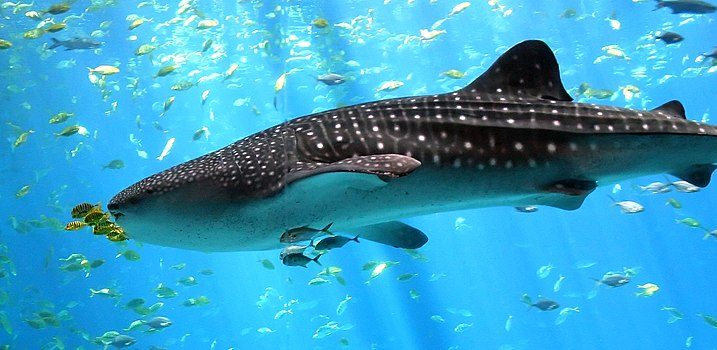In 2016, the whale shark was deemed endangered by the IUCN Red List, with an estimate of only 200 thousand left in the oceans. There have been protection acts on this specific species for over 20 years, with the first one starting in India in 2001, according to the Wildlife Trust of India. Even with all of these precautions put in place, whale shark populations continue to decline due to hunting them for food.
Taroko was a whale shark that lived in the Georgia Aquarium in Atlanta for 18 years. He was rescued from a fish market in Taiwan in 2007, where he and his brother Yushan would have been used for food. This was before the ban of capturing or selling sharks in Taiwan, which took effect in 2008. Taroko was the center of 43 million eyes that came to Atlanta to watch his beauty and grace in the years that he was there. Yet, on August 20, Taroko was euthanized in the Georgia Aquarium after they “noticed a decline in his health”, according to WHSV. While the method was not mentioned, most marine life is put down by “sedation to reduce pain and stress,” then they are given an “injectable or inhalant drug,” according to the NOAA Fisheries.
Whalesharks are able to live up to 130 years, and while veterinarians do not know Taroko’s actual age, it is assumed that he only lived for around 25 years. Which poses the question: does captivity protect whale sharks from hunting, or is the tank driving the species towards extinction too?
For centuries, sharks have been hunted and killed for cultural dishes in countries like China, India and Indonesia. Whale sharks specifically were used for their meat, fins and skin until bans began to spread across the world to protect these animals. The most recent ban on hunting and eating whale sharks was in Mozambique in January of 2021, according to the Marine Megafauna Foundation. This is five years after the whale shark was labeled as endangered. Despite two decades of protections for this species, humans are still evading these prohibitions.Even with these bans, many individuals are still killing and selling whale sharks. According to a graph on the National Library of Medicine, in the time between September 2002 and September 2022, there were 17 whale sharks on record that still got butchered for food. This does not include the off-record whale sharks that get stranded on beaches until death and are later butchered, or the ones who get killed under the radar. Keeping whale sharks in the wild brings a risk of being used for food. Even if the numbers are small, the killing of these sharks is making the population of whale sharks dwindle to numbers lower than 200 thousand. But do they stand more of a chance in the wild, or could captivity protect them to grow their life span?
There has been plenty of mention about the risky lives of whale sharks in the ocean due to humans feasting on this species, but keeping them in a tank for ‘protection’ has not seemed to do much to help them either. Before Taroko and Yushan arrived in the Georgia Aquarium, there have been four other whale sharks, all captured from Taiwan food markets: Ralph, Norton, Alice and Trixie. Ralph was considered a “teenager,” according to NBC News. With whale sharks, they reach adulthood at 25-30 years old, so Ralph had not even reached the age of sexual maturity. Norton passed away at just 3-4 years old in 2007 after being put in captivity just two years before. Alice’s age was never discussed but she was described as an “adult-aged” whale shark, according to The Albany Herald. Trixie passed at approximately 15 years old. In comparison, a whale shark in the wild can live up to 130 years, but the longest a captive whale shark has ever lived is 26 years. The similarity between these sharks? Every death was caused by a “deteriorating health decline,” according to the MarineBio Conservation Society.
However, whale sharks commonly die from plenty of factors, including “the lasting trauma from wild capture and transportation, extreme stress of confinement, refusing to eat and eventually succumbing to illness or injury,” BornFreeUSA, a nonprofit business dedicated to wildlife conservation, said. Capture is shaving years away from whale sharks, and both situations, captivity and freedom, are hard for them when trying to live.
As a passionate marine lover, whale sharks have been my favorite sea creature since I learned about the giant but graceful spotted shark. I have always wanted to go to the Georgia Aquarium to visit the last captives of this species. Taroko and Yushan were a dream of mine, but after the death of Taroko and seeing the treatment of these animals, I no longer wish to be a witness to the struggle they are put through. I personally think freedom is better for whale sharks, even risking the butchering of them. Keeping whale sharks in captivity can be beneficial when it comes to monitoring the animals and for research purposes to compare them to ones in the wild.
However, I do not think that the proper location to prevent death and keep health in order is in a tank. Marine biologists cannot accommodate every aspect of the life of a whale shark to keep them happy, such as seasonal migration, mating and stress prevention. “Marine mammals simply cannot thrive in captivity. Almost all marine mammal species are wide-ranging predators and the best we can provide for them are barren concrete boxes or small sea pen corrals,” said Dr. Naomi Rose, a lead author and marine mammal scientist in the Animal Welfare Institute. If humans cannot figure out how to safely keep whale sharks in captivity, then we should keep them out of the tanks and in the ocean instead.




















